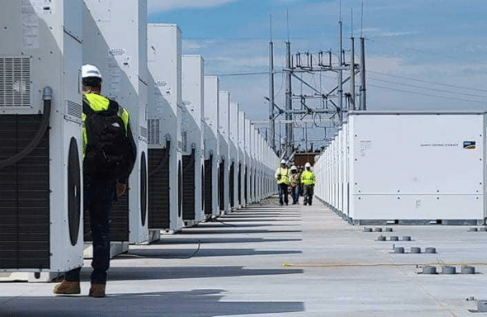
The U.S. Department of Energy (DOE) has submitted a proposal that, if approved, would help speed up certain transmission, solar, and storage projects built on federal land, while clogged interconnection queues are causing headaches in the industry.
The proposed changes would affect how the DOE complies with the National Environmental Policy Act (NEPA), adding a “categorical exclusion” for certain energy storage systems and revising categorical exclusions for upgrading and rebuilding transmission lines and for solar photovoltaic systems. These exclusions would remove the requirement for environmental assessments or environmental impact statements for specific types of projects.
The DOE requested a single categorical exclusion for energy storage systems, limited to electrochemical-battery and flywheel energy storage systems. The DOE says it has “not identified sufficient information to conclude that compressed air energy storage, thermal energy storage (e.g., molten salt storage), or other technologies normally do not present the potential for significant environmental impacts.”
Under the proposed rules, the construction, operation, upgrade, or decommissioning of an electrochemical-battery or flywheel energy storage system within a previously disturbed or developed area would also receive a simplified review.
In 2011, DOE proposed changes to three related categorical exclusions for energy storage: power storage (such as flywheels and batteries, generally less than 10 MW), load shaping projects (such as the installation and use of flywheels and battery arrays). Now, the DOE has proposed to not include the 10 MW limit in the new categorical exclusion because capacity is not a reliable indicator of potential environmental impacts.
Additionally, the DOE proposed removing the “20 miles in length or less” categorical exclusions limitation for upgrading or rebuilding existing powerlines. DOE proposed to remove the mileage limitation, add options for relocating within an existing right of way or within otherwise previously disturbed or developed lands, and add new conditions.
DOE also proposed to clarify options for relocating powerlines within the scope of categorical exclusion. Relocating segments of a powerline can improve resilience, avoid sensitive resources, or serve other purposes. Currently, “minor relocations of small segments of the powerlines” are approved for exclusion, but the DOE proposed removing “minor” and specifying that, under the proposed revisions, small segments of powerlines may be relocated “within an existing right of way or within otherwise previously disturbed or developed lands.”
The categorical exclusions for solar photovoltaic systems currently include the installation, modification, operation, and removal of solar PV systems located on a building or other structure or, if located on land, within a previously disturbed or developed area generally comprising less than 10 acres. DOE proposes to change “removal” of a solar PV system to “decommissioning,” and proposed to remove the acreage limitation for proposed projects. Based on DOE’s experience, acreage is not a reliable indicator of potential environmental impacts.
The DOE recently released a draft roadmap to address interconnection challenges on the transmission grid. The plan is intended to serve as a practical guide for implementing near- and long-term solutions to interconnect clean energy sources and to clear the existing backlog of solar, wind, and battery projects seeking construction.
The country will need to dramatically expand the deployment of solar and wind energy resources to meet the Biden-Harris Administration’s goal of a decarbonized electricity sector by 2035, DOE said. However, increased incentives and growing demand for renewable energy have exacerbated long wait times for the clean energy projects seeking to connect to the grid.
New clean energy projects are subject to complicated approval processes before they come online. The high volume of projects seeking interconnection has led to uncertainties, delays, inequities, and added costs for developers, consumers, utilities, and their regulators.
Earlier this year, the Federal Energy Regulatory Commission (FERC) issued a final ruling in its quest to streamline generator interconnection and alleviate clogged queues across the U.S.
The final rule requires all public utilities to adopt revised pro forma generator interconnection procedures and agreements to ensure that interconnection customers can interconnect to the transmission system in a reliable, efficient, transparent, and timely manner, and to prevent undue discrimination.
FERC will require a “first-ready, first-served” cluster study process in which transmission providers conduct large interconnection studies encompassing numerous proposed generating facilities, rather than separate studies for each individual generating facility. To ensure that ready projects can proceed through the queue in a timely manner, interconnection customers will be subject to specific requirements, including financial deposits and site control conditions, to enter and remain in the interconnection queue.